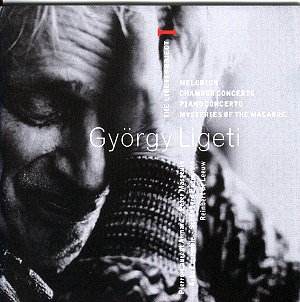To those of us who care deeply about music written
since World War 2, the demise of Sony’s Complete Ligeti Edition was
something of a body blow. Luckily, Teldec have stepped in, re-named
it The Ligeti Project, and more or less taken up where Sony left off.
As much of the chamber, vocal and solo piano works had already been
well served on Sony’s seven volumes, Teldec have concentrated so far
on orchestral and concerto (or concertante) pieces. This does mean a
possible risk of duplication for the keen collector, but each of the
new discs not only gives us superbly authoritative versions of the familiar
fare, but ‘spices’ things up by adding a number of world premiere recordings.
One such item is the very first on the disc, Melodien,
dating from 1971 and written for fairly large chamber orchestra. The
composer tells us that the title refers to "the particular nature
of the instrumental writing, in which individual voices are markedly
melodic in style". It is in a single movement, and Ligeti refers
rather poetically (but aptly) to "contrasting kinetic elements
… flowing along like a river, each of whose meanderings differs considerably
from the next one". The experienced composer-conductor, Reinbert
de Leeuw obviously understands this shifting structure well, as he beautifully
teases out individual lines without losing sight of the whole. There
is a permanent state of tension within what Ligeti calls a ‘soft’ harmonic
context, and these suspensions are rarely released. A climactic point
is reached (roughly at the half way point) and a gradual subsiding,
though not really any comfortable resolution.
The Chamber Concerto comes from immediately
before Melodien, and is one of Ligeti’s most popular works. It
has had a number of recordings, the best of which is Boulez on a cheap,
desirable DG Classikon issue (coupled with Schnittke and Lutosławski).
The work is extremely resourceful and is scored for thirteen instruments,
the same number as Berg’s Chamber Concerto, though a different
combination (Ligeti scores his for five strings, four woodwinds, two
brass and two keyboard players). Again, Ligeti is less concerned with
an alternation of tutti and solo, and more concerned with exploiting
individual soloistic timbres within a concertante framework. The opening
movement is mostly textural, built up of "micropolyphonically interwoven
lines that are constantly overlapping and merging". The second
is more static (though no less effective) and the third exemplifies
his obsession with a rhythmic structure built around ‘clockwork devices’
(not dissimilar to his 1962 Poème symphonique for 100
metronomes). The cat-and-mouse finale, described by the composer as
‘an insanely virtuosic Presto’, is superbly played by the Dutch ensemble,
who are clearly revelling in the daunting challenges Ligeti has set
them.
The Piano Concerto may well, for many, be the
main item on the disc. It was written for the Bonaventura brothers,
Anthony and Mario, but has found its truest champion recently in the
phenomenal Pierre-Laurent Aimard. His Sony disc of the taxing Etudes
for Piano won a clutch of awards (rightly so), and this is his second
recording of the Concerto, his first being with Boulez on a very
desirable DG disc which also features the Cello and Violin
Concertos. This new recording is just as fine, indeed possibly even
better in its assured execution of some very complicated material. The
opening movement, for instance, shows how Aimard is easily able to overcome
the rhythmic hurdles and make Ligeti’s phase-like structure (not unlike
American minimalism) sound spontaneous and unforced, even dance-like.
Indeed, this piece is closely linked with the first volume of Etudes,
and was part of Ligeti’s avowed intention of "turning towards more
distinct and transparent crystalline musical structures". He sees
this compositional process as being analogous to the relationship between
pixels and images on a television screen – the pixels light up and disappear
in rapid succession, without moving, but the illusion of movement is
created and the surface ‘lives’. The Piano Concerto fully exploits
this idea of ‘graininess’, and enthusiasts who know his 1968 piece for
harpsichord, Continuum, will know what to expect. These rhythmic
patterns are largely inspired by his African studies, and the instrumentation
around the piano also backs this up, with the accent on exotic percussion
and a pulsating forward momentum. Anyone expecting a nasty, dissonant
mess need not worry – the results here are an infectious, even intoxicating
cocktail that Aimard describes, not unreasonably, as "the finest
of all contemporary piano concertos, a combination of perfect control
and sheer madness".
The final short, encore-style item, Mysteries of
the Macabre, is also a premiere recording, though it may be familiar
to keen enthusiasts. It is an arrangement of three arias sung by the
Chief of the Secret Police in the opera Le Grand Macabre. It
is a variant of the same arrangement for coloratura soprano, and was
re-scored for trumpet and chamber orchestra by another Ligeti champion,
Elgar Howarth. The grotesque humour and sheer bizarreness of the original
come over well, and the use of solo trumpet adds another dimension,
giving the whole entertainment a tenuous but audible link back to Stravinsky’s
Soldier’s Tale.
The whole disc is a success. There is competition in
the bigger items, though the present performances are easily as authoritative
as any, being fully supervised by the composer, who also provides illuminating
liner notes. The recordings, as so often with this company, are demonstration
worthy, and one can only conclude with a vote of thanks to Teldec for
taking up the mantle of this important series.
Tony Haywood
